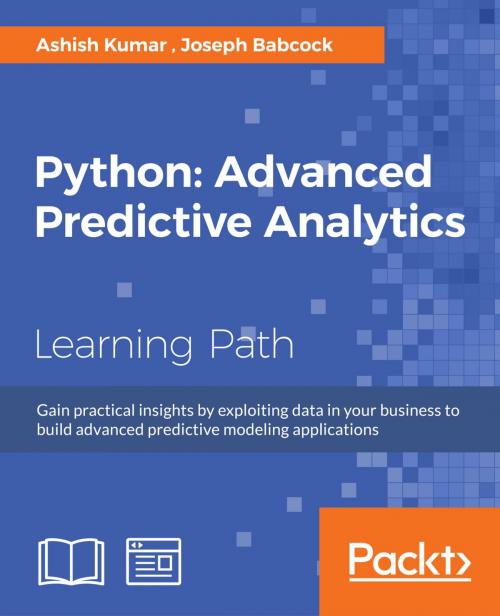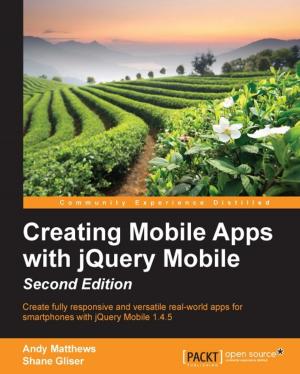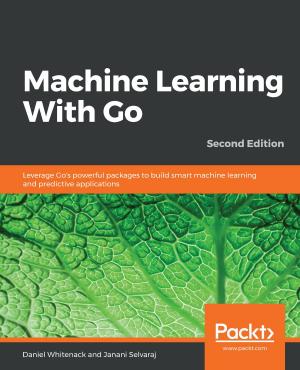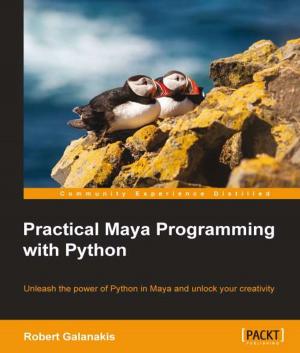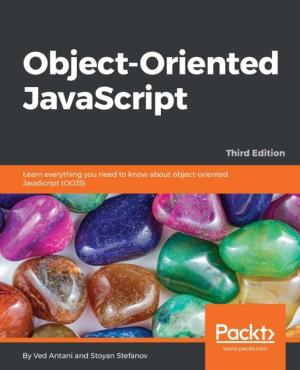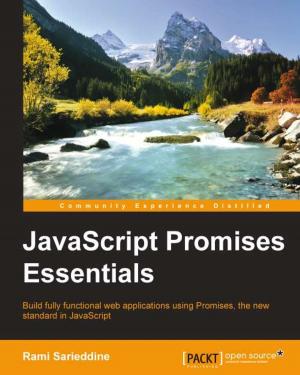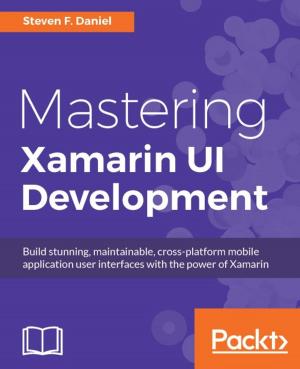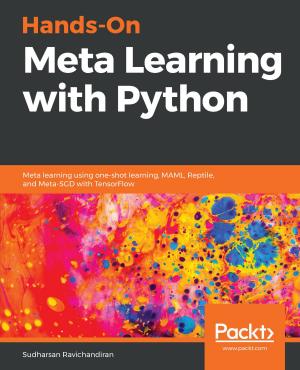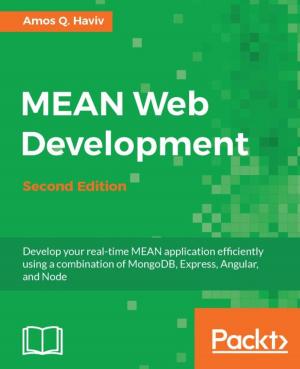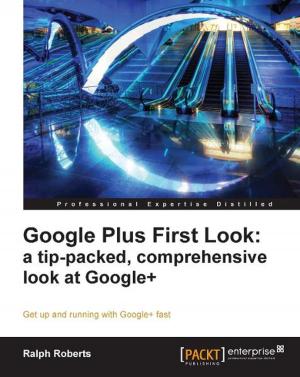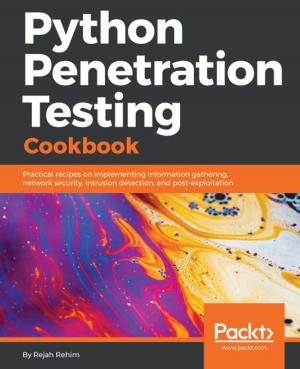Python: Advanced Predictive Analytics
Gain practical insights by exploiting data in your business to build advanced predictive modeling applications
Nonfiction, Computers, Advanced Computing, Programming, Data Modeling & Design, Artificial Intelligence, General Computing| Author: | Joseph J, Ashish Kumar | ISBN: | 9781788993036 |
| Publisher: | Packt Publishing | Publication: | December 27, 2017 |
| Imprint: | Packt Publishing | Language: | English |
| Author: | Joseph J, Ashish Kumar |
| ISBN: | 9781788993036 |
| Publisher: | Packt Publishing |
| Publication: | December 27, 2017 |
| Imprint: | Packt Publishing |
| Language: | English |
Gain practical insights by exploiting data in your business to build advanced predictive modeling applications
Key Features
- A step-by-step guide to predictive modeling including lots of tips, tricks, and best practices
- Learn how to use popular predictive modeling algorithms such as Linear Regression, Decision Trees, Logistic Regression, and Clustering
- Master open source Python tools to build sophisticated predictive models
Book Description
Social Media and the Internet of Things have resulted in an avalanche of data. Data is powerful but not in its raw form; it needs to be processed and modeled, and Python is one of the most robust tools out there to do so. It has an array of packages for predictive modeling and a suite of IDEs to choose from. Using the Python programming language, analysts can use these sophisticated methods to build scalable analytic applications. This book is your guide to getting started with predictive analytics using Python.
You'll balance both statistical and mathematical concepts, and implement them in Python using libraries such as pandas, scikit-learn, and NumPy. Through case studies and code examples using popular open-source Python libraries, this book illustrates the complete development process for analytic applications. Covering a wide range of algorithms for classification, regression, clustering, as well as cutting-edge techniques such as deep learning, this book illustrates explains how these methods work. You will learn to choose the right approach for your problem and how to develop engaging visualizations to bring to life the insights of predictive modeling.
Finally, you will learn best practices in predictive modeling, as well as the different applications of predictive modeling in the modern world. The course provides you with highly practical content from the following Packt books:
-
Learning Predictive Analytics with Python
-
Mastering Predictive Analytics with Python
What you will learn
- Understand the statistical and mathematical concepts behind predictive analytics algorithms and implement them using Python libraries
- Get to know various methods for importing, cleaning, sub-setting, merging, joining, concatenating, exploring, grouping, and plotting data with pandas and NumPy
- Master the use of Python notebooks for exploratory data analysis and rapid prototyping
- Get to grips with applying regression, classification, clustering, and deep learning algorithms
- Discover advanced methods to analyze structured and unstructured data
- Visualize the performance of models and the insights they produce
- Ensure the robustness of your analytic applications by mastering the best practices of predictive analysis
Who this book is for
This book is designed for business analysts, BI analysts, data scientists, or junior level data analysts who are ready to move on from a conceptual understanding of advanced analytics and become an expert in designing and building advanced analytics solutions using Python. If you are familiar with coding in Python (or some other programming/statistical/scripting language) but have never used or read about predictive analytics algorithms, this book will also help you.
Gain practical insights by exploiting data in your business to build advanced predictive modeling applications
Key Features
- A step-by-step guide to predictive modeling including lots of tips, tricks, and best practices
- Learn how to use popular predictive modeling algorithms such as Linear Regression, Decision Trees, Logistic Regression, and Clustering
- Master open source Python tools to build sophisticated predictive models
Book Description
Social Media and the Internet of Things have resulted in an avalanche of data. Data is powerful but not in its raw form; it needs to be processed and modeled, and Python is one of the most robust tools out there to do so. It has an array of packages for predictive modeling and a suite of IDEs to choose from. Using the Python programming language, analysts can use these sophisticated methods to build scalable analytic applications. This book is your guide to getting started with predictive analytics using Python.
You'll balance both statistical and mathematical concepts, and implement them in Python using libraries such as pandas, scikit-learn, and NumPy. Through case studies and code examples using popular open-source Python libraries, this book illustrates the complete development process for analytic applications. Covering a wide range of algorithms for classification, regression, clustering, as well as cutting-edge techniques such as deep learning, this book illustrates explains how these methods work. You will learn to choose the right approach for your problem and how to develop engaging visualizations to bring to life the insights of predictive modeling.
Finally, you will learn best practices in predictive modeling, as well as the different applications of predictive modeling in the modern world. The course provides you with highly practical content from the following Packt books:
-
Learning Predictive Analytics with Python
-
Mastering Predictive Analytics with Python
What you will learn
- Understand the statistical and mathematical concepts behind predictive analytics algorithms and implement them using Python libraries
- Get to know various methods for importing, cleaning, sub-setting, merging, joining, concatenating, exploring, grouping, and plotting data with pandas and NumPy
- Master the use of Python notebooks for exploratory data analysis and rapid prototyping
- Get to grips with applying regression, classification, clustering, and deep learning algorithms
- Discover advanced methods to analyze structured and unstructured data
- Visualize the performance of models and the insights they produce
- Ensure the robustness of your analytic applications by mastering the best practices of predictive analysis
Who this book is for
This book is designed for business analysts, BI analysts, data scientists, or junior level data analysts who are ready to move on from a conceptual understanding of advanced analytics and become an expert in designing and building advanced analytics solutions using Python. If you are familiar with coding in Python (or some other programming/statistical/scripting language) but have never used or read about predictive analytics algorithms, this book will also help you.
